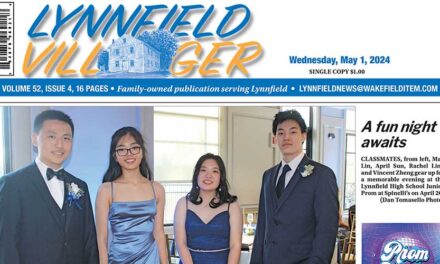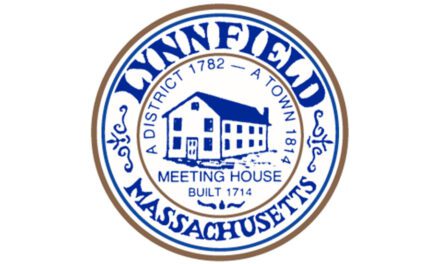Published in the May 16, 2018 edition
By DAN TOMASELLO
LYNNFIELD — The town is looking to make roadway corridor improvements to Summer Street, Bayside Engineering representatives said at a public hearing on May 9.
Bayside Engineering President Norman Brown said the firm has been hired by the town in order to make improvements to Summer Street. He said the town is looking to receive state and federal funds as part of a Transportation Improvement Plan (TIP) project, which would be administered by the Massachusetts Department of Transportation (MassDOT).
While local officials advertised the public hearing, there were no residents in the audience. As a result, Town Engineer Charlie Richter plans on holding another hearing on Tuesday, June 12, beginning at 7 p.m. in the Al Merritt Media and Cultural Center.
Brown noted retired DPW Director Dennis Roy discussed the project with Bayside representatives and the state’s project development engineer four years ago.
“They determined Summer Street was a viable candidate to receive federal funding,” said Brown.
While Brown said the project was stagnant for a couple of years, he said Richter and DPW Director John Tomasz decided to move forward with the project.
Brown said the corridor improvements to Summer Street would go from Main Street to Salem Street.
“It may get cut down in phases or (the town) might want to take some of it out,” said Brown. “Or (the town) could do it for the entire roadway length.”
Brown said Summer Street has “a lot of distressed pavement and distressed sidewalks.” He said the street’s sidewalks need to be widened.
“One of the other needs is the town wanted to try and urge children to ride their bikes and walk to and from school,” said Brown.
According to Bayside’s report, Summer Street’s roadway surface is “severely cracked, rutted and, in many instances, de-laminating.” The report noted Summer Street has “significant pedestrian activity,” but stated the current sidewalk condition “does not meet current standards, poses a risk to users and does not meet handicap accessibility requirements.”
Additionally, the report stated Summer Street has “moderate bicyclist usage,” but does not have “adequate bicycle protections.”
Senior Highway Engineer Michael Rizzo unveiled two alternatives being considered as part of the project. Under Alternative 1, Rizzo said the 50-foot layout would have two 11-foot travel lanes, two five-foot shoulders on each side of the road to accommodate bicyclists, and two five-and-a-half foot sidewalks on each side of the road.
Rizzo said Alternative 2 is slightly different, as a 10-foot wide shared use path would be built on one side of Summer Street in order to accommodate both pedestrians and bicyclists. He said Alternative 2 also includes the 50-foot layout, two 11-foot wide travel lanes and two 2-foot-wide shoulders. He said a three-foot-wide grass strip located between the shoulder and shared use path would be constructed as well.
According to Rizzo, the two alternatives “will not require any land takings.” However, he said temporary easements or permanent easements might be needed. He said the permanent easements would be needed for utility poles.
“Generally, temporary easements are required for most corridor projects,” said Rizzo. “Sometimes permanent utility easements are necessary. On Summer Street, about 80 to 90 percent of the utility poles are on the easterly side of the road.”
Drainage, stormwater improvements
Senior Civil and Environmental Engineer Bree Sullivan said the project would include constructing a drainage system and a stormwater management system. She said untreated stormwater runoff is the primary reason why Pillings Pond is listed as “impaired” by the state.
“Pillings Pond receives about 25 percent of the runoff from this corridor,” said Sullivan. “It’s definitely a significant contributor to some of the issues at Pillings Pond. There are water clarity issues and there can be excess algae in the summer. There appears to be some nuisance aquatic vegetation.”
Sullivan said the Pillings Pond culvert would be reconstructed as part of the project. She said upgrading the culvert would have a positive impact on local wildlife, as a number of turtle deaths have occurred on Summer Street.
“Turtles can’t go through the culvert, so they go over the road,” said Sullivan. “We hope to reduce that. We will also have better storm resilience, as the culverts won’t clog as easily and it will have lower maintenance needs.”
Sullivan said residents will be able to weigh in on the culvert’s design.
“We don’t want to put something in that looks like it should be in downtown Boston,” said Sullivan.
Intersections
Senior Project Engineer Bruno Campea gave an overview of proposed intersection improvements.
“All of these intersections would be reviewed during the design process,” said Campea.
Campea noted there are three intersections near the Common: Main Street at Summer Street, Main Street at South Common Street, and South Common Street at Summer Street.
“The town of Lynnfield actually requested the Boston Region Metropolitan Planning Organization to study these locations because of traffic and safety conditions around that area,” said Campea. “The organization collected traffic data and analyzed these locations. What was found was two of the three locations were experiencing significant delays as well as long queues. Those locations were Summer Street at Main Street, and South Common Street at Main Street. The analysis showed the locations were experiencing a failed level of service.”
Campea said the MPO’s report recommended that the town investigate two alternatives in order to address traffic congestion. He said one recommendation was closing South Common Street and changing the street into a green space. He said a traffic light would need to be installed at Main Street and Summer Street. He also said Main Street and Summer Street would need to be widened.
The second alternative proposed by the MPO would be to change South Common Street into a one-way road, which Campea said would be accessible by motorists traveling on Main Street.
DPW Director John Tomasz noted a number of residents in town oppose installing traffic lights.
“That could be one of those things people don’t buy into,” said Tomasz.
Campea said Bayside Engineering will be evaluating intersections at Summer Street and Walnut Street, and Summer Street at Salem Street as part of the project.
Next steps
As part of the first step of the project, Brown said Bayside Engineering is requesting residents to fill out a form about the project. He said the form will be available in the Town Clerk’s office and DPW office.
“After we compile the comments, we would prepare a project initiation form that MassDOT wants to see,” said Brown.
Brown noted MassDOT will reviewing the project closely during each phase. If the project moves forward, Brown anticipates it will take eight years to complete.
“It’s a long process,” said Brown.




